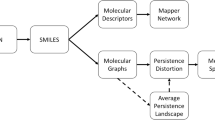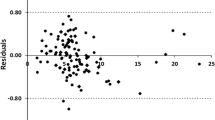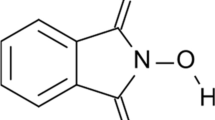Abstract
The optimization of correlation weights scheme was used to model the water solubility (ln S) of diverse functional aliphatic compounds (n=193). The optimized descriptor formulated based on the data of a training set (n=96) generated statistically acceptable relations for the training set (r2=0.987), test set (n=97; r2=0.986) and combined set (r2=0.987). When the relation of ln S values with the optimized molecular descriptor formulated based on the data of the training set was used for the calculation of ln S values of the training set, r 2pred value was found to be satisfactory (0.988), which is indicative of the predictive potential of the scheme. The results indicate the promising potential of the optimization of correlation weights scheme in modeling studies.
Similar content being viewed by others
References
Harary F (1971) Graph theory. Addison-Wesley, Reading, MA
Balaban AT (ed) (1976) Chemical application of graph theory. Academic Press, London
Trinajstic N (1992) Chemical graph theory, 2nd edn. CRC Press, Boca Raton
Devillers J, Balaban AT (eds) (1999) Topological indices and related descriptors in QSAR and QSPR. Gordon and Breach Science Publishers, The Netherlands
Ivanciuc O (1998) Structural similarity measures for database searching. In: Schleyer PvR, Allinger NL, Clark T, Gasteiger J, Kollman PA, Schaefer HF, Schniener PR (eds) Encyclopedia of computational chemistry. Wiley, Chichester
Boncher D, Rouvray DH (eds) (1991) Chemical graph theory. Introduction and Fundamentals. Academic Press, New York
Balaban AT (ed) (1997) From chemical topology to three-dimensional geometry. NewYork
Kier LB, Hall LH (1976) Molecular connectivity in chemistry and drug research. Academic Press, New York
Kier LB, Hall LH (1986) Molecular connectivity in structure-activity analysis. Research Studies Press, Letchworth
Todeschini R, Consonni V (2000) Handbook of molecular descriptors. Wiley-VCH, Weinheim, Germany
Kier LB (1989) Quant Struct-Act Relat 8:218–223
Randic M (1991) J Comput Chem 12:970–980
Randic M (1991) Chemom Intell Lab Syst 10:213–227
Randic M (1991) J Chem Inf Comput Sci 31:311–320
Randic M (1992) J Chem Inf Comput Sci 32:686–692
Estrada E (1995) J Chem Inf Comput Sci 35:1022–1025
Amic D, Beslo D, Lucic D, Nikolic S, Trinajstic N (1998) J Chem Inf Comput Sci 38:819–822
Randic M, Basak SC (1999) J Chem Inf Comput Sci 39:261–266
Sinha DK, Basak SC, Mohanty RK, Basumallick IN (1999) Some aspects in mathematical chemistry. Visva-Bharati University Press, Santiniketan
Toropov AA, Toropova AP (1998) Russ J Coord Chem 24:81–85
Toropov AA, Toropova AP, Voropaeva NL, Ruban IN, Rashidova SS (1998) J Coord Chem 24:525–529
Toropov AA, Voropaeva NL, Ruban IN, Rashidova SS (1999) Polym Sci Ser A 41:975–985
Krenkel G, Castro EA, Toropov AA (2001) J Mol Struct (THEOCHEM) 542:107–113
Mercader A, Castro EA, Toropov AA (2001) J Mol Model 7:1–5
Mercader A, Castro EA, Toropov AA (2000) Chem Phys Lett 330:612–623
Krenkel G, Castro EA, Toropov AA (2001) J Mol Sci 2:57–65, http://www.mdpi.org/ijms
Marino DJG, Perruzo PJ, Castro EA, Toropov AA (2002) Internet Electron J Mol Des 1:115–133, http://www.biochempress.com
Duchowicz P, Castro EA, Toropov AA (2002) Computers and Chemistry 26:327–332
Toropov AA, Duchowicz P, Castro EA (2003) Int J Mol Sci 4:272–283, http://www.mdpi.org/ijms
Perruzo PJ, Marino DJG, Castro EA, Toropov AA (2003) Internet Electron J Mol Des 2:334–347, http://www.biochempress.com
Toropov AA, Schultz TW (2003) J Chem Inf Comput Sci 43:560–567
Toropov AA, Roy K (2004) J Chem Inf Comput Sci 44:179–186
Kubinyi H (1995) Quantitative structure-activity relationships. In: Wolff ME (ed) Burger’s medicinal chemistry and drug discovery, 5th edn, vol 1. John Wiley New York, pp 497–571
Ghose AK, Crippen GM (1987) J Chem Inf Comput Sci 27:21–35
Ghose AK, Viswanadhan VN, Wendoloski JJ (1998) J Phys Chem 102:3762–3772
Bodor N, Gabanyi Z, Wong C-K (1989) J Am Chem Soc 111:3783–3786
Klopman G, Wang S (1991) J Comput Chem 12:1025–1032
Moriguchi I, Hirono S, Liu Q, Nakagome I, Matsushita Y (1992) Chem Pharm Bull (Tokyo) 40:127–130
Saxena AK (1995) Quant Struct-Act Relat 14:142–150
Benet LZ, Kroetz DL, Sheiner LB (1996) In: Hardman JG, Limbard LE, Molinoff PB, Ruddon RW, Goodman Gilman A (eds) Goodman and Gilman’s The pharmacological basis of therapeutics. Mc-Graw Hill, New York, pp 3–27
Ferreira MM (2001) Chemosphere 44:125–146
Khadikar PV, Mandloi F, Bajaj AV, Joshi S (2003) Bioorg Med Chem Lett 13:419–422
Katritzky AR, Wang Y, Sild S, Tamm T (1998) J Chem Inf Comput Sci 38:720–725
Yin C, Liu X, Guo W, Lin T, Wang X, Wang L (2002) Water Res 36:2975–2982
Chen XQ, Cho SJ, Li Y, Venkatesh S (2002) J Pharm Sci 91:1838–1852
Roy K, Saha A (2003) Internet Electron J Mol Des 2:475–491, http://www.biochempress.com
Yang F, Wang ZD Huang YP (2004) J Comput Chem 25:881–887
Wanchana S, Yamashita F, Hashida M (2002) Pharmazie 57:127–129
Gao H, Shanmugasundaram V, Lee P (2002) Pharm Res 19:497–503
Puri S, Chickos JS, Welsh WJ (2003) J Chem Inf Comput Sci 43:55–62
Liu R, So SS (2001) J Chem Inf Comput Sci 41:1633–1639
Butina D, Gola JM (2003) 43:837–841
Hansch C, Quinlan JE, Lawrence GL (1968) J Org Chem 33:347–350
The program for optimization of correlation weights was developed in PASCAL by Toropov AA
The GW-BASIC programs RRR98, KRPRES1 and KRPRES2 were developed by Kunal Roy (1998) and standardized using known data sets.
Snedecor GW, Cochran WG (1967) Statistical Methods. Oxford& IBH Publishing Co. Pvt. Ltd., New Delhi, pp 381–418
Kier LB, Hall LH (1992) Atom description in QSAR models: development and use of an atom level index. In: Testa B (ed) Advances in drug research, vol 22. Academic Press, New York, pp 1–38
Wold S, Eriksson L (1995) Validation tools. In: van de Waterbeemd H (ed) Chemometric methods in molecular design. VCH, Weinheim, pp 309–318
Author information
Authors and Affiliations
Corresponding author
Rights and permissions
About this article
Cite this article
Roy, K., Toropov, A.A. QSPR modeling of the water solubility of diverse functional aliphatic compounds by optimization of correlation weights of local graph invariants. J Mol Model 11, 89–96 (2005). https://doi.org/10.1007/s00894-004-0224-7
Received:
Accepted:
Published:
Issue Date:
DOI: https://doi.org/10.1007/s00894-004-0224-7




